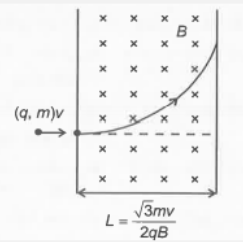A particle of mass m, charge q and kinetic energy T enters in a transverse uniform magnetic field of induction B. After the 3 s, the kinetic energy of the particle will be
3T
2T
T
4T
The correct Answer is:c
To solve the problem, we need to understand the effect of a magnetic field on a charged particle. Here’s a step-by-step breakdown of the solution:
Step 1: Understand the scenario
A particle with mass m, charge q, and initial kinetic energy T enters a uniform magnetic field with induction B. The magnetic field is transverse, meaning it is perpendicular to the direction of the particle's motion.
Hint: Remember that the magnetic field affects the motion of charged particles but does not change their kinetic energy.
Step 2: Analyze the effect of the magnetic field
When a charged particle moves through a magnetic field, it experiences a magnetic force that is perpendicular to both the velocity of the particle and the magnetic field. This force causes the particle to move in a circular path, but it does not do work on the particle.
Hint: Recall that the work done by a force is related to the change in kinetic energy. If the force is perpendicular to the velocity, no work is done.
Step 3: Conclude about the kinetic energy
Since the magnetic force does not do any work on the particle, the kinetic energy of the particle remains unchanged as it moves through the magnetic field. Therefore, after 3 seconds, the kinetic energy of the particle will still be T.
Hint: Think about the conservation of energy in the context of forces acting on the particle.
Final Answer
The kinetic energy of the particle after 3 seconds in the magnetic field will be T.
A particle with mass m, charge q, and initial kinetic energy T enters a uniform magnetic field with induction B. The magnetic field is transverse, meaning it is perpendicular to the direction of the particle's motion.
When a charged particle moves through a magnetic field, it experiences a magnetic force that is perpendicular to both the velocity of the particle and the magnetic field. This force causes the particle to move in a circular path, but it does not do work on the particle.
Since the magnetic force does not do any work on the particle, the kinetic energy of the particle remains unchanged as it moves through the magnetic field. Therefore, after 3 seconds, the kinetic energy of the particle will still be T.
The kinetic energy of the particle after 3 seconds in the magnetic field will be T.
Similar Questions
A particle of mass m has momentum p. Its kinetic energy will be
View SolutionCooling decreases the kinetic energy of particles.
View SolutionA particle of mass m and charge Q moving with a velocity v enters a region on uniform field of induction B Then its path in the region is s
View SolutionIf a charged particle enters perpendicular in the uniform magnetic field then
View SolutionA particle of mass m and charge q is placed at rest in a uniform electric field E and then released, the kinetic energy attained by the particle after moving a distance y will be
View SolutionAssertion An α−particle and a deuteron having same kinetic energy enter in a uniform magnetic field perpendicular to the field. Then, radius of circular path of α−particle will be more.
Reason qm ratio of an α−particle is more than the qm ratio of a deuteron.
View SolutionA charged particle of mass m and charge q is released from rest in an electric field of constant magnitude E. The kinetic energy of the particle after time t is
View SolutionA charge particle of mass m and charge q enters in a region of uniform magnetic field as shown in figure.The magnitude of change in linear momentum due to magnetic field will be

View SolutionTwo particles of masses m and 2m and charges 2q and q are placed in a uniform electric field E and allowed to move for the same time. The ratio of kinetic energies will be -
View SolutionWhen a charged particle enters a uniform magnetic field its kinetic energy
View Solution
